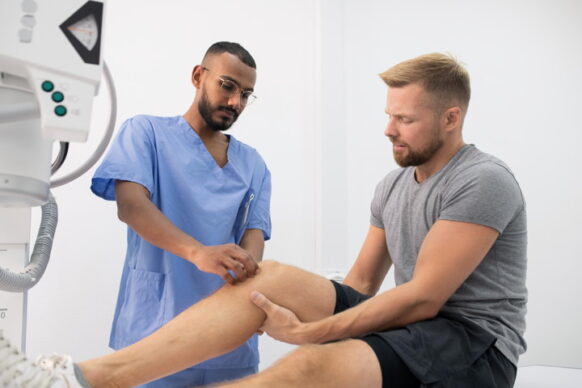What Athletes Need to Know About Deltoid Strains – Dr. Brian Ludwig

Shoulder pain in an athlete is a very common malady. Pain in the shoulder can be debilitating for athletes of all ages and competition levels. One possible, but relatively uncommon, cause of shoulder pain is called a deltoid strain.
What is the Deltoid Muscle and What Does it Do?
The deltoid muscle is a large muscle that encompasses the shoulder joint. The deltoid is divided into three different portions, or heads – the anterior (front), middle, and posterior (back) portions of the deltoid. The deltoid originates on the lateral aspect of the acromion and clavicle and then inserts on the lateral aspect of the humerus. Its major action is to abduct the arm (lift the arm out to the side of the body) as well as assist in forward elevation (lifting the arm out in front of the body). The deltoid is a very powerful muscle and is needed for all types of athletic endeavors.
What is the Difference Between a Strain and a Sprain?
Strains are injuries to muscles or muscle tendon units. Sprains are injuries to ligaments. Because the deltoid is a muscle, it can be strained, but not sprained.
What Other Injuries Can Mimic a Deltoid Strain?
There are many injuries in the shoulder that can mimic a deltoid strain. At times, these injuries can be difficult to distinguish from one another. Some other nearby areas that can be injured include the rotator cuff, glenoid labrum, biceps tendon, or acromioclavicular joint (AC joint). Shoulder dislocations, shoulder fractures, and soft tissue contusions are also possible. Many of these injuries can be treated conservatively, however some of these injuries require surgical intervention and need to be evaluated by a sports medicine physician to determine the extent of the injury.
How Does One Get a Deltoid Strain?
Deltoid strains can be caused by numerous mechanisms. Most commonly, they result from overuse of the muscle without adequate rest. This can lead to discomfort in the area of the deltoid muscle with associated swelling and loss of function. A forced eccentric contraction of the shoulder (lengthening of the muscle belly while contracting) can lead to strain of the deltoid muscle (ie: doing a “negative” while weight lifting). Less commonly, a direct traumatic blow to the shoulder can cause a deltoid strain.
How are Deltoid Strains Diagnosed?
Deltoid strains are diagnosed by looking at the mechanism of injury and the symptoms the patient is having at the time of injury. A physical examination is imperative. Patients with deltoid strains can have pain with palpation of the involved area of the deltoid muscle belly. In more severe cases with actual tears of the muscle, a palpable defect may be felt. The shoulder is also assessed for swelling and skin changes. Range of motion and strength testing are done to help confirm the diagnosis of a deltoid strain and rule out other possible diagnoses.
What Imaging Studies are Needed in a Patient with a Deltoid Strain?
Depending on the mechanism of injury, no imaging studies may be needed. If there is concern for fracture or dislocation, radiographs of the shoulder may be indicated. Additionally, if there is concern for rotator cuff injury or a torn labrum, then an MRI of the shoulder, on rare occasions, may be necessary.
What are the Different Grades (Severity) of Deltoid Strains?
Deltoid strains are graded based on the severity of the injury. Grade I strains generally result in mild pain in the affected shoulder. Patients with grade I strains are able to use their shoulder and can lift their arms with minimal pain and are able to do push-ups without much difficulty. There will generally be minimal or no swelling. Grade II strains are the next level of severity. This level of injury represents a partial tearing of the deltoid muscle. A patient with a grade II strain will have increased pain in the shoulder. They may have difficulty doing push-ups or lifting their arm. There will generally be mild or moderate swelling. Grade III strains are the most severe. A patient with a grade III strain typically has tearing of the deltoid muscle belly. The patients typically have severe pain and dysfunction in their arm. They are not able to use their arm for activities and will have moderate to severe swelling.
How are Deltoid Strains Treated?
In general, deltoid strains are treated conservatively. For Grade I injuries, generally little treatment is needed. Initially, most patients can benefit from sports injury treatment using the P.R.I.C.E. principle – Protection, Rest, Icing, Compression, Elevation. Anti-inflammatory medications (ibuprofen) can be used to treat the pain symptomatically. Grade II injuries can be treated similarly. A brief period of physical therapy may be helpful to decrease pain and increase motion in the arm. Grade III injuries, the most severe, are treated with physical therapy and restricted activities. Only on the very rare occasion would surgery be needed for a deltoid strain.
When Can an Athlete Get Back to Sporting Activities After a Deltoid Strain?
Depending on the severity of the strain, athletes can return to a sport within a day or two, or up to several weeks to months later. In order to safely return to athletic competition, the athlete must have regained all of their strength, as well as range of motion (ROM). After this has been regained, often sport specific exercises are initiated (such as a throwing program for the throwing athlete). Once the athlete is pain free, has full strength and ROM, and has completed their sport specific exercises, if appropriate, then they may return to play without restriction. For minor, grade I type injuries this can be done very quickly, whereas more severe grade III injuries may need several months of recovery. Return to play decisions should be determined under the guidance of a sports medicine professional and possibly an athletic trainer or physical therapist.
About Dr. Brian Ludwig

Dr. Brian Ludwig is one of our fellowship-trained sports medicine specialists at OrthGeorgia. His areas of focus include sports medicine and total joint care, with special interest in athletic injuries, ACL reconstruction, arthroscopy of the shoulder and knee, fracture care, and total joint reconstruction (knee and shoulder). He is a team physician for several local sports teams and regularly provides athletic screenings for high school and college athletes. Patients can meet with Dr. Ludwig for comprehensive orthopaedic care at our offices in Warner Robins , Kathleen, and Hawkinsville.
Sports Medicine Care for Athletes in Central GA
At OrthoGeorgia, athletes of all kinds can find the comprehensive care they need to help them get back in the game after a sports injury. The members of our team are committed to the prevention, care, and rehabilitation of all athletic injuries, and focus on returning each athlete back to play with full range of motion, strength, endurance, and function. Our physicians collaborate with our physical therapists to create customized sports medicine rehabilitation programs when needed as well. We proudly provide our sports medicine care alongside spine care, hand care, total joint care, and foot & ankle care. To learn more about how we can help you live more comfortably, contact the OrthoGeorgia location nearest you to schedule an appointment today.

Personalized Orthopaedic Care in Central Georgia
At OrthoGeorgia, we want to help you live a healthier and more comfortable life by giving those in Macon, Warner Robins, Kathleen, Milledgeville, Dublin, Hawkinsville, and the surrounding areas convenient access to the highest quality care. Whether you have been suffering from a sports injury or a common orthopaedic condition, we will determine the cause of your discomfort and craft a personalized treatment plan to bring you relief. To learn more about our services and our physicians, or to schedule an appointment at OrthoGeorgia, please contact us today.







